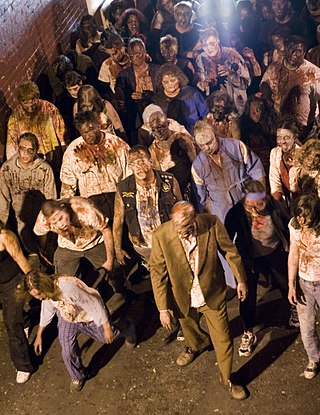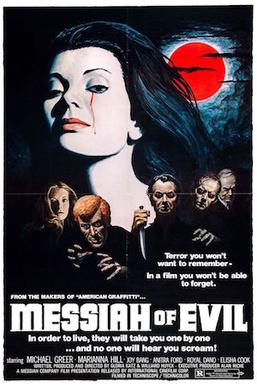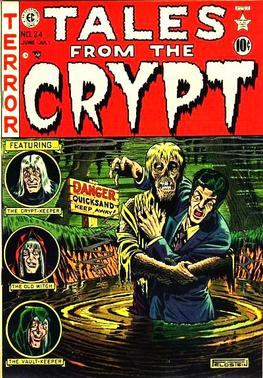
The Evil Dead is a 1981 American independent supernatural horror film written and directed by Sam Raimi. The film stars Bruce Campbell, Ellen Sandweiss, Richard DeManincor, Betsy Baker, and Theresa Tilly as five college students vacationing in an isolated cabin in the woods, where they find an audio tape that, when played, releases a legion of demons and spirits. Four members of the group suffer from demonic possession, forcing the fifth member, Ash Williams (Campbell), to survive an onslaught of increasingly gory mayhem.
Resident Evil, known as Biohazard in Japan, is a Japanese horror game series and media franchise created by Capcom. It consists of survival horror, third-person shooter and first-person shooter games, with players typically surviving in environments inhabited by zombies and other mutated creatures. The franchise has expanded into other media, including a live-action film series, animated films, television series, comic books, novels, audiobooks, and merchandise. Resident Evil is the highest-grossing horror franchise.

George Andrew Romero Jr. was an American-Canadian film director, writer, editor and actor. His Night of the Living Dead series of films about a zombie apocalypse began with the original Night of the Living Dead (1968) and is considered a major contributor to the image of the zombie in modern culture. Other films in the series include Dawn of the Dead (1978) and Day of the Dead (1985).

An exploitation film is a film that tries to succeed financially by exploiting current trends, niche genres, or lurid content. Exploitation films are generally low-quality "B movies", though some set trends, attract critical attention, become historically important, and even gain a cult following.

Zombi 2 is a 1979 English-language Italian zombie film directed by Lucio Fulci. It was adapted from an original screenplay by Dardano Sacchetti to serve as a sequel to George A. Romero's Dawn of the Dead (1978), which was released in Italy under the title Zombi. It stars Tisa Farrow, Ian McCulloch, and Richard Johnson, and features a score by frequent Fulci collaborator Fabio Frizzi. Frizzi's score has been released independently of the film, and he has performed it live on tour.
Japanese horror is horror fiction derived from popular culture in Japan, generally noted for its unique thematic and conventional treatment of the horror genre differing from the traditional Western representation of horror. Japanese horror tends to focus on psychological horror, tension building (suspense), and the supernatural, particularly involving ghosts (yūrei) and poltergeists. Other Japanese horror fiction contains themes of folk religion such as possession, exorcism, shamanism, precognition, and yōkai. Media in which the genre of Japanese horror fiction can be found include artwork, theater, literature, film, anime and video games.

White Zombie is a 1932 pre-Code horror film independently produced by Edward Halperin and directed by Victor Halperin. The screenplay by Garnett Weston, based on The Magic Island by William Seabrook, is about a young woman's transformation into a zombie at the hands of an evil voodoo master. Bela Lugosi stars as the zombie master "Murder" Legendre, with Madge Bellamy appearing as his victim. Other cast members include Joseph Cawthorn, Robert W. Frazer, John Harron, Brandon Hurst, and George Burr MacAnnan.

Brian Pulido is a creator, writer and producer of comic books and films.

A zombie is a mythological undead corporeal revenant created through the reanimation of a corpse. In modern popular culture, zombies are most commonly found in horror genre works. The term comes from Haitian folklore, in which a zombie is a dead body reanimated through various methods, most commonly magical practices in religions like Vodou. Modern media depictions of the reanimation of the dead often do not involve magic but rather science fictional methods such as fungi, radiation, gases, diseases, plants, bacteria, viruses, etc.

Zombie apocalypse is a subgenre of apocalyptic and post-apocalyptic fiction in which society collapses due to overwhelming swarms of zombies. Typically only a few individuals or small bands of survivors are left living. In some versions, the reason the dead rise and attack humans is unknown, in others, a parasite or infection is the cause, framing events much like a plague. Some stories have every corpse rise, regardless of the cause of death, whereas others require exposure to the infection.

Messiah of Evil is a 1973 American supernatural horror film co-written, co-produced, and co-directed by Willard Huyck and Gloria Katz, and starring Marianna Hill, Michael Greer, Anitra Ford, Royal Dano, and Elisha Cook Jr. Its plot follows a woman who travels to a remote coastal town in California to find her missing artist father; upon arrival, she finds herself in the midst of a series of bizarre incidents.

Matthew Stuart "Matt" Busch is an American artist and entertainment illustrator.
FrightFest, also known as Arrow Video FrightFest is an annual film festival held in London and Glasgow. The festival holds three major events each year: a festival running five days over the UK late August Bank Holiday weekend, a Halloween event held in London in late October, and a festival in Glasgow held around February as part of the Glasgow Film Festival.

A zombie film is a film genre. Zombies are fictional creatures usually portrayed as reanimated corpses or virally infected human beings. They are commonly portrayed as cannibalistic in nature. While zombie films generally fall into the horror genre, some cross over into other genres, such as action, comedy, science fiction, thriller, or romance. Distinct subgenres have evolved, such as the "zombie comedy" or the "zombie apocalypse". Zombies are distinct from ghosts, ghouls, mummies, Frankenstein's monsters or vampires, so this article does not include films devoted to these types of undead.

Doctor Blood's Coffin is a 1961 British horror film produced by George Fowler, and directed by Sidney J. Furie. It stars Kieron Moore, Hazel Court, and Ian Hunter. The story is that of young biochemist Dr Peter Blood, who returns to his hometown in Cornwall with the belief that he can selectively restore life by transplanting the living hearts of 'undeserving' people into dead people who 'deserve' to live. The film is significant for being one of the first two zombie films to be shot in colour, the other being the obscure 1961 American film The Dead One, and for its early portrayal of zombies as homicidal rotting cadavers. The movie was released in the UK in January 1961 and in the US in April of that year, where it was on a double bill with another British film, The Snake Woman (1961).

Horror comics are comic books, graphic novels, black-and-white comics magazines, and manga focusing on horror fiction. In the US market, horror comic books reached a peak in the late 1940s through the mid-1950s, when concern over content and the imposition of the self-censorship Comics Code Authority contributed to the demise of many titles and the toning down of others. Black-and-white horror-comics magazines, which did not fall under the Code, flourished from the mid-1960s through the early 1980s from a variety of publishers. Mainstream American color comic books experienced a horror resurgence in the 1970s, following a loosening of the Code. While the genre has had greater and lesser periods of popularity, it occupies a firm niche in comics as of the 2010s.
John Michael Fasano was an American screenwriter, film producer and director.
KNB EFX Group is an American special effects company that specializes in prosthetic makeup, animatronics, and other practical effects. It was founded in 1988 by Robert Kurtzman, Greg Nicotero, and Howard Berger, though Kurtzman left in 2003. After establishing a reputation for gory effects in horror films throughout the late 1980s and early 1990s, they broadened to performing animatronics and makeup effects for mainstream comedy and drama films. Their work on The Chronicles of Narnia: The Lion, the Witch and the Wardrobe and The Walking Dead have netted them multiple awards and nominations.

Karoly Grosz was a Hungarian–American illustrator of Classical Hollywood–era film posters. As art director at Universal Pictures for the bulk of the 1930s, Grosz oversaw the company's advertising campaigns and contributed hundreds of his own illustrations. He is especially recognized for his dramatic, colorful posters for classic horror films. Grosz's best-known posters advertised early Universal Classic Monsters films such as Dracula (1931), Frankenstein (1931), The Mummy (1932), The Invisible Man (1933), and Bride of Frankenstein (1935). Beyond the horror genre, his other notable designs include posters for the epic war film All Quiet on the Western Front (1930) and the screwball comedy My Man Godfrey (1936).
A horror game is a video game genre centered on horror fiction and typically designed to scare the player. The term may also be used to describe tabletop games with horror fiction elements.














